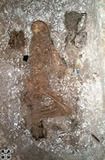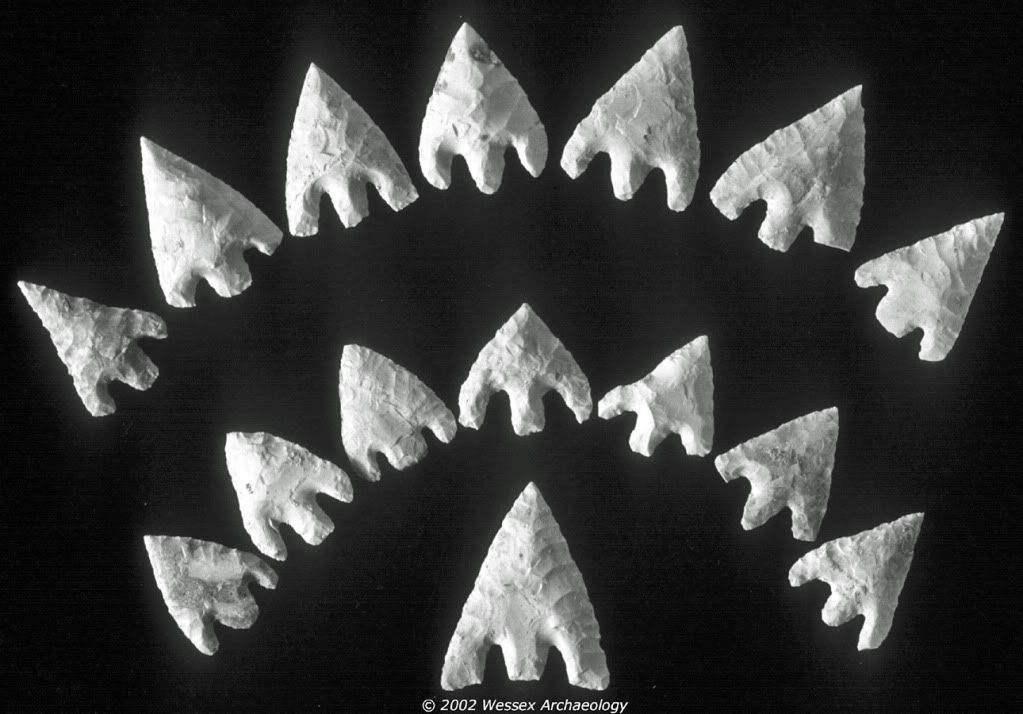The Stonehenge Burials
The Amesbury Archer – King of Stonehenge?
 The richest of the burials associated with Stonehenge, and the wealthiest ever discovered from Bronze Age Britain, was found amidst Roman graves at Amesbury, 5km (2 miles) south-east of the monument. This high status burial, known as either the ‘Amesbury Archer’ or the ‘King of Stonehenge’, and dated between 2400 and 2200 BC, yielded an astonishing array of grave goods for the period.
The richest of the burials associated with Stonehenge, and the wealthiest ever discovered from Bronze Age Britain, was found amidst Roman graves at Amesbury, 5km (2 miles) south-east of the monument. This high status burial, known as either the ‘Amesbury Archer’ or the ‘King of Stonehenge’, and dated between 2400 and 2200 BC, yielded an astonishing array of grave goods for the period.
Found alongside the skeleton were five ‘Beaker’ pots, sixteen beautifully-worked flint arrowheads, boar’s tusks, two sandstone wristguards (to protect the wrists from the bow string of a bow and arrow), a pair of gold hair ornaments, three tiny copper knives, a kit of flint-knapping and metalworking tools, and a shale belt ring. The discovery of such rich grave goods with this burial indicates a high-status individual who was also probably one of the earliest metalworkers in the islands.
Fascinatingly, chemical analysis showed that one of the Archer’s copper knives was of Spanish origin and the gold may also have come from outside Britain. Studies of the skeletal remains by Jackie McKinley of Wessex Archaeology revealed that the Archer was a strongly-built man aged between 35 and 45, though he had an abscess on his jaw and had suffered an accident when young which had torn his left knee cap off. Thus for much of his life the ‘Archer’ would have walked with a pronounced limp.
But the most surprising element of the Archer’s story was yet to come. Research using oxygen isotope analysis on his tooth enamel found that he had grown up in the Alps region – Switzerland, Austria or Germany. The Archer is thought to have come to Britain at a very young age – perhaps when a child. Why did he travel such a long distance? Was it perhaps to seal an alliance between distant peoples? Or did he possess some kind of ‘magical’ skills (the ‘mystical’ new art of metalworking perhaps?) which were believed to be necessary in the building of parts of Stonehenge?
 If the latter is true, perhaps the unusually rich burial of the ‘King of Stonehenge’, obviously an important person of high rank, means that he played an important part in the construction of the first stone-built monument on the site.
If the latter is true, perhaps the unusually rich burial of the ‘King of Stonehenge’, obviously an important person of high rank, means that he played an important part in the construction of the first stone-built monument on the site.
Interestingly, a second burial, dating from the same period as the Archer, was located near to his grave. This skeleton, that of a male aged around 20-25, which bone analysis has shown to be either the Archer’s son, brother or cousin, had been buried with a pair of gold hair ornaments in the same style as the Archer’s, though for some reason these had been left inside the man’s jaw. Oxygen isotope analysis revealed that this man had grown up in the area around Salisbury Plain, though his late teens may have been spent in the Midlands or north-east Scotland. These fascinating burials obviously represent important people, but were they kings or priests of some kind, or perhaps members of a local ruling clan or family?




